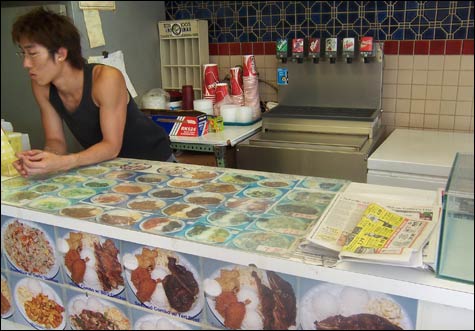
SEEFOOD: Pick what looks the best, and order. |
As local scholar Paul Burlin explains in his book Imperial Maine and Hawaii, it was Mainers who were largely responsible for the conquest of the island nation that became our 50th state. This means, according to traditional practice, that it is our right, even our duty, to mercilessly exploit them for everything we can. With this in mind, I traveled to Hawaii to see what ideas we might steal from their cuisine.
The most obvious point of connection between these two oceanside states is seafood. The Hawaiian approach to seafood is undeniably more interesting and adventurous than our own atlantic approach to fish. This is in part because of the sorts of fish that turn up on the menu, for example the pleasantly oily monchong we tried at Alan Wong’s Pineapple Room, and the yellowtail, which has been liberated from sushi menus to appear in restaurants around the islands. But compared to Maine — where we so often taste our fish with butter, lemon, capers, and tomato broths — it is the boldness and variety of preparation that strikes you most when you eat seafood here. That monchong was crab crusted with a very light and mild lobster curry sauce that offered a hint of lemongrass — a complex set of flavors that never felt like a muddle. We also tried a more familiar swordfish, topped with an aioli dusted with a tart and salty Japanese furikake and accompanied by even more tart pickled apricots.
Chefs like Russel Siu of 3660 on the Rise simmer and steam their fish in broths of miso or black bean, offering subtle Asian flavors without making their menus feel Japanese or Chinese. Siu, Wong, Sam Choy, and Roy Yamaguchi are masters at creating very light crusts for their seafood to experiment with texture without overwhelming the fish the way we tend to when we fry. On the other end of texture spectrum, in Hawaii the creamy texture of uncooked fish has been liberated from the tyranny of sushi. Varieties of poke, made most often from cubes of ahi tuna dressed with some mixture of soy, vinegar, onions, chilies, ginger, seaweed, and sesame, allow the sweetness of the fish to emerge more readily than the wasabi and soy bathing we give it at sushi bars. In many places a similar preparation is given to seared cubes of tofu, which plays almost no role on Maine menus.
Hawaiians have also embraced obesity, which is a clever idea since we are all going to get fat eventually anyway. While they love a buffet, the typical Hawaiian midday meal is a “plate lunch” which consists of a huge pile of meat with two big scoops of white rice and one of a macaroni-mayonnaise salad. It is unconscionable and can be terrific. The best was the slow-cooked pulled pork of Kalua pig, and the tender, sour, garlicky pork adobo available at Keneke’s in Waimanalo on the eastern shore of Oahu. You eat at picnic tables in a crudely constructed indoor/outdoor dining room. The concrete walls are covered in the most vindictive quotations that can be harvested from the Bible, articles about the Keneke’s-sponsored “Fear God Powerlifting Team,” and photos of chubby Hawaiian kids jerking outrageously heavy barbells. Where can large Maine kids go to feel better about their weight by lifting its equivalent over their heads? Nowhere.